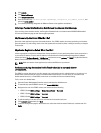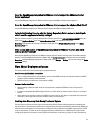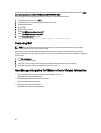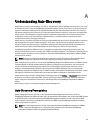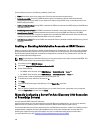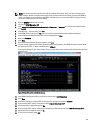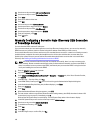
A
Understanding Auto-Discovery
Auto-Discovery is the process of adding a 11th, 12th, or 13th generation of Dell PowerEdge bare-metal server into a pool
of available servers for use by the OpenManage Integration for VMware vCenter. Once a server is discovered, use it for
hypervisor and hardware deployment. This appendix provides sufficient information about Auto-Discovery to help you
with system configuration. Auto-Discovery is a Lifecycle Controller feature for setting up a new server and registering it
using a console. The advantages of using this capability include removing the need to do cumbersome manual local
configuration of a new server and enabling an automated way for a console to discover a new server that was
connected to the network and plugged into power.
Auto-Discovery is sometimes referred to as
Discovery and Handshake
after the process it performs. When a new server
with the Auto-Discovery feature enabled is plugged in to AC power and connected to the network, the Dell server’s
Lifecycle Controller attempts to
discover
a deployment console that was integrated with the Dell provisioning server.
Auto-Discovery then initiates a
handshake
between the provisioning server and the Lifecycle Controller.
OpenManage Integration for VMware vCenter is a deployment console with an integrated provisioning server. The
location of the provisioning server is provided to the iDRAC using different methods. The IP address or host name for the
provisioning server location is set to the IP address or host name of the OpenManage Integration for VMware vCenter
appliance virtual machine.
NOTE: A new server configured for Auto-Discovery attempts to resolve the location of the provisioning server
every 90 seconds over a period of 24 hours, after which you can manually reinitiate Auto-Discovery.
When the Auto-Discovery request is received by the OpenManage Integration for VMware vCenter for VMware vCenter,
it validates the SSL certificate and then initiates any optionally configured security procedures, such as client side
security certificates and validation against a white list. A second validation request from the new server returns
temporary username/password credentials to be configured on the iDRAC. Subsequent calls are initiated by the
OpenManage Integration for VMware vCenter for VMware vCenter, which gathers information about the server, remove
the temporary credentials, and configure more permanent user-defined credentials for administrative access
If Auto-Discovery was successful, the deployment credentials provided in the Settings → Deployment page at the time
of discovery are created on the target iDRAC. Then the Auto-Discovery feature is turned off. The server should now
appear in the pool of available bare-metal servers under Deployment in the OpenManage Integration for VMware
vCenter.
Auto-Discovery can be currently done through the vSphere Desktop client.
Auto-Discovery Prerequisites
Before attempting to discover 11th, 12th, or later generation Dell PowerEdge bare-metal servers, install the
OpenManage Integration for VMware vCenter. Only 11th generation Dell PowerEdge or later servers with iDRAC Express
or iDRAC Enterprise can be discovered into the OpenManage Integration for VMware vCenter’s pool of bare-metal
servers. Network connectivity from the Dell bare-metal server’s iDRAC to the
OpenManage Integration for VMware
vCenter virtual machine is required.
NOTE: Hosts with existing hypervisors should not be discovered into the OpenManage Integration for VMware
vCenter, instead, add the hypervisor to a connection profile, and then reconciled with the OpenManage
Integration for VMware vCenter
using the Host Compliance Wizard
101




